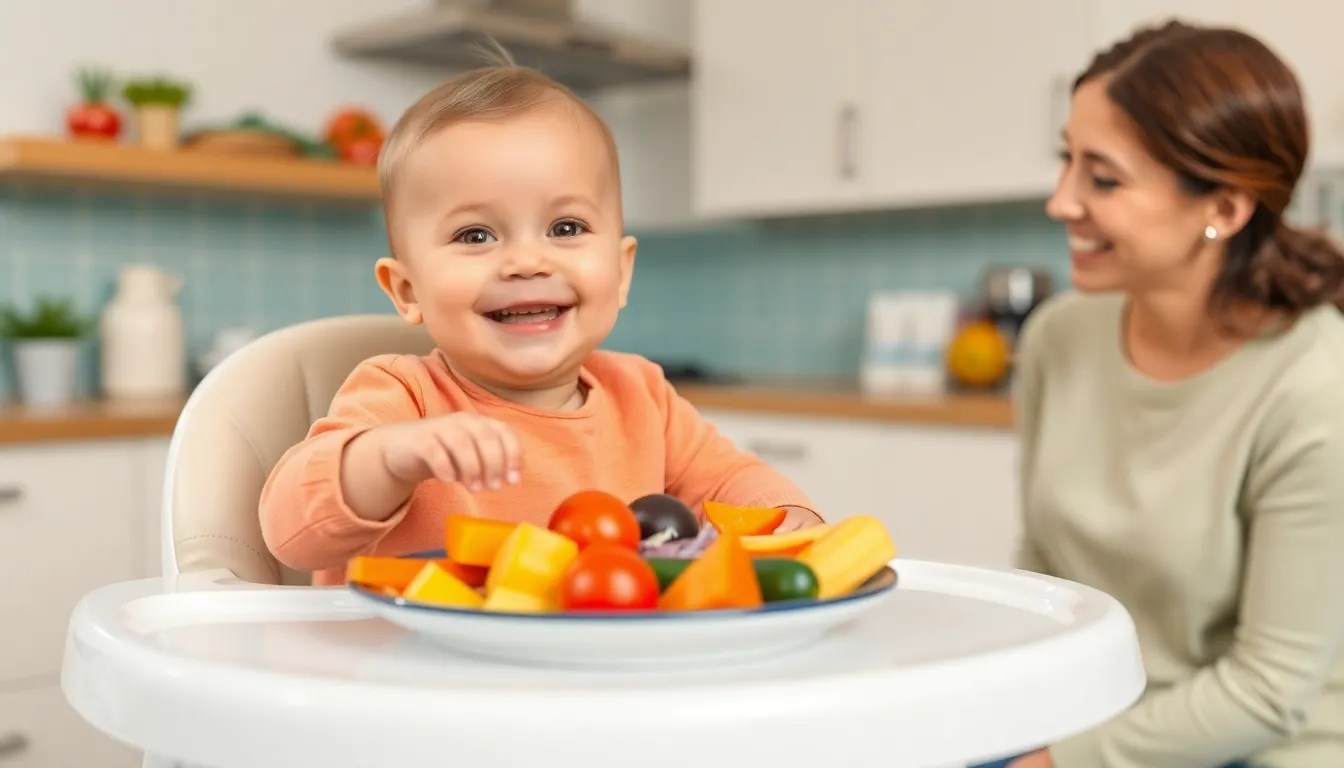As parents dive into the world of feeding their little ones, the question of when to start baby-led weaning often pops up like a surprise broccoli in a baby’s puree. It’s a fun and messy adventure that promises to turn mealtime into a delightful exploration of flavors and textures. But how do you know when your mini food critic is ready to take the plunge?
Typically, experts recommend starting this exciting journey around six months of age. By then, babies are usually sitting up, showing interest in food, and ready to channel their inner foodies. So grab those bibs and prepare for some giggles as your baby learns to navigate the culinary landscape—one squished carrot at a time! After all, who knew that mealtime could be a full-contact sport?
Table of Contents
ToggleUnderstanding Baby Led Weaning
Baby-led weaning allows infants to self-feed, promoting independence and exploration. Around six months of age, babies often show readiness by sitting up independently and exhibiting interest in family meals. Parents play a crucial role in this process by providing a safe and engaging environment.
Mealtimes enhance the sensory experience with a variety of textures and flavors. Introducing soft vegetables, fruits, and grains encourages babies to grasp and explore food at their own pace. Examples include steamed carrots and avocado, both of which are easy for tiny hands to hold.
Creating a positive atmosphere is essential. Families can join in, making mealtime a shared experience. Encouraging babies to participate in meals helps them develop motor skills and social interactions.
Monitoring for signs of readiness is vital. A baby may indicate they’re prepared to start when they can reach for food and bring it to their mouth. It’s important to ensure foods are cut into appropriate sizes to reduce choking hazards.
Choosing the right foods enhances the learning experience. Nutritious options promote optimal growth, including options like soft banana slices and cooked sweet potato.
Maintaining patience is key. Babies make a mess while learning, which is entirely normal. Embracing this messiness transforms mealtime into a memorable adventure.
Benefits of Baby Led Weaning

Baby-led weaning offers multiple advantages for infants and parents. Emphasizing exploration and independence enhances the mealtime experience.
Promotes Self-Feeding Skills
Babies learn to self-feed through baby-led weaning, encouraging motor skills development. Experimenting with different food shapes helps strengthen hand-eye coordination. Engaging with various textures allows infants to adapt to new foods comfortably. Grasping soft food items builds confidence and fosters autonomy. This hands-on approach nurtures a positive relationship with food early on, setting the stage for future eating behaviors.
Encourages Healthy Eating Habits
Healthy eating habits form naturally with baby-led weaning as babies choose what they want to eat. Exposure to diverse flavors and textures helps expand their palate. Parents presenting nutritious options cultivates an appreciation for healthy foods over time. Engaging in shared family meals promotes social interaction, reinforcing healthy choices. This method supports balanced eating patterns, establishing a foundation for lifelong dietary habits.
When Do You Start Baby Led Weaning?
Starting baby-led weaning typically occurs when the baby shows readiness, often around six months. Parents observe important cues to ensure the baby is prepared for this self-feeding journey.
Signs Your Baby Is Ready
Readiness for baby-led weaning includes several signs. When a baby can sit up independently, it indicates sufficient physical development. Interest in food, such as reaching for it or expressing excitement during mealtime, also suggests readiness. The ability to pick up objects and bring them to the mouth shows fine motor skills are developing. Additionally, the disappearance of the tongue-thrust reflex, which prevents choking, signals the baby can handle solid foods. Monitoring these cues ensures a safe and engaging transition into solid foods.
Recommended Age Range
Most experts recommend starting baby-led weaning around six months of age. At this age, babies typically demonstrate better control of their head and neck, vital for safe eating. Some may start as early as five months if they show readiness signs. However, introducing solids before four months is not recommended due to infant digestive development. Parents should consult pediatricians if uncertain about their baby’s readiness. Ensuring the right timing fosters a successful beginning to self-feeding and exploration.
Tips for Starting Baby Led Weaning
Starting baby-led weaning requires careful planning and consideration. This process invites babies to explore foods on their terms while ensuring safety and nutrition.
Safety Precautions
Keep safety as a top priority during mealtimes. Ensure that the baby sits upright in a high chair during meals to prevent choking incidents. Always supervise babies while eating, as they might experiment with food in unexpected ways. Cut foods into appropriate sizes; sticks or small pieces work best to minimize choking hazards. Avoid introducing foods that pose high allergy risks, like honey and whole nuts, until after the first year. Familiarize yourself with choking techniques, like the Heimlich maneuver, as additional precaution. When in doubt, consult a pediatrician for guidance on safe feeding practices.
Foods to Introduce First
Choose nutritious first foods that encourage self-feeding. Soft fruits like avocado and banana serve as great starting options. Cooked vegetables, such as sweet potatoes and carrots, provide a range of flavors and textures. Grain options like well-cooked pasta or toast strips contribute to variety in the diet. Offer a mix of foods to foster exploration and instill curiosity about textures and tastes. Maintain a balance of flavors to promote healthy eating habits from the beginning. Allow babies to explore the foods freely, ensuring mealtimes remain engaging and enjoyable.
Starting baby-led weaning is an exciting milestone that can transform mealtime into a joyful exploration for both baby and parent. By recognizing signs of readiness around six months, parents can confidently embark on this journey. Offering a variety of nutritious foods in a safe environment allows babies to develop essential skills while enjoying the process. It’s important to remain patient and embrace the messiness that comes with self-feeding. With careful planning and a focus on safety, baby-led weaning can lay the groundwork for healthy eating habits and a positive relationship with food, setting the stage for a lifetime of nutritious choices.



